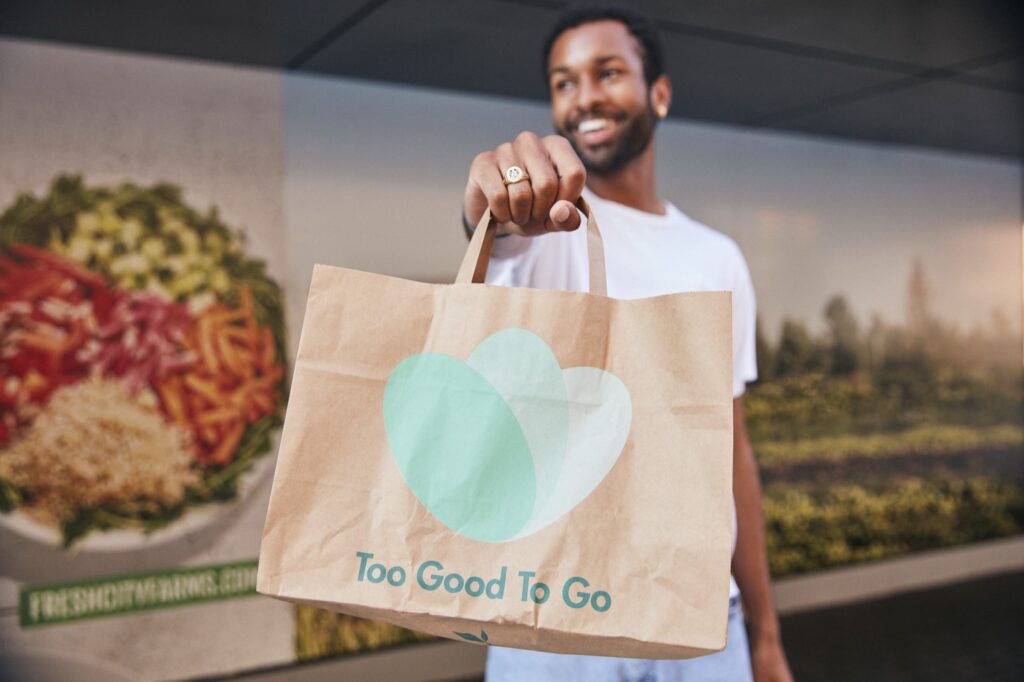Introduction

In a world where over 18 million tons of food go to waste annually across the restaurant and grocery sectors alone, Too Good To Go has emerged as a transformative force in combating food waste. Founded in Denmark in late 2015, this app has redefined how businesses and consumers interact with surplus food, turning waste into opportunity and driving a significant environmental and economic impact.
What Is Too Good To Go?
Too Good To Go is a unique mobile application that connects consumers with restaurants, bakeries, grocery stores, and retailers offering surplus food at heavily discounted prices. The platform operates on the concept of “surprise bags,” which are curated packages of unsold food available at the end of the day. These bags, priced between $3.99 and $9.99 in the United States, offer an average of 70% savings for consumers.
The twist? Customers don’t know exactly what they’ll get until they pick up the bag, adding a sense of adventure and excitement to the experience. This gamified approach, coupled with its sustainability mission, has attracted over 100 million users and 170,000 retail partners worldwide.
The Problem of Food Waste
Globally, food waste costs the economy an estimated $1 trillion annually. In the United States alone:
- The restaurant and food service industry discards over $130 billion worth of food each year.
- Grocery stores account for another $30 billion in wasted food.
- Overall, a third of all food goes uneaten, contributing to significant financial losses and environmental harm.
Food is the number one product in U.S. landfills, and addressing this issue is critical for reducing greenhouse gas emissions and conserving resources.
How Too Good To Go Works
The process is simple yet effective:
- Businesses List Surplus Food: Restaurants, bakeries, and retailers upload details of their leftover food onto the app.
- Consumers Reserve Surprise Bags: Customers browse nearby listings, select a surprise bag, and pay via the app.
- Pick Up and Save: Consumers pick up their surprise bags during designated windows, enjoying significant savings while reducing food waste.
The flexibility for businesses to price their bags and the affordable pricing for consumers make this model a win-win.
The Numbers Behind the Success
Since its inception, Too Good To Go has seen exponential growth:
- In 2023, the app sold over 102 million surprise bags, a 29% increase from the previous year.
- It generated $162 million in revenue in the same year, with a projected 10% growth in 2024.
- The platform’s revenue primarily comes from transaction fees ($1.79 per order in the U.S.) and an $89 annual membership fee for participating retailers.
These figures highlight the growing consumer demand for affordable, sustainable food options and the effectiveness of Too Good To Go in addressing food waste
A Case Study: Impact on Businesses and Consumers
For businesses, partnering with Too Good To Go has been transformative. Consider Fyahbun Creative, a small Jamaican restaurant in New York City:
- Before joining the app in 2020, the restaurant faced daily losses due to unsold food.
- By listing surplus items on Too Good To Go, they not only reduced waste but also generated additional revenue and attracted new customers.
Consumers, on the other hand, are drawn to the app for its affordability and variety. A frequent user shared that the app allowed them to explore local eateries and even discover new favorites, often leading to repeat visits at full price.
Overcoming Challenges
Despite its success, Too Good To Go faces several challenges:
- Market Saturation: As the app expands, reaching new businesses in established markets may become more difficult.
- Competition: Rivals like Olio and Karma offer similar services, with Karma allowing consumers to choose their surplus food.
- Regulatory Barriers: Varying food safety laws across countries can complicate expansion efforts.
- Partner Independence: Large grocery chains may eventually opt to create their own surplus food systems, bypassing the app.
A Vision for the Future
Too Good To Go continues to innovate and expand. Recent developments include:
- Partnerships with major brands like Whole Foods Market, offering new types of surprise bags, such as prepared meals and bakery items.
- Geographic expansion, with the app now active in 33 major U.S. metro areas and multiple continents.
- Diversification into grocery services and software solutions for food retailers.
The company’s CEO, Mette Lykke, emphasizes balancing profitability with impact. While the business achieved its first profitable month in October 2022 and a positive EBITDA of $8 million in 2023, its primary focus remains on scaling globally and driving change in the food waste space.
Environmental and Economic Impact
By saving surplus food from landfills, Too Good To Go delivers significant environmental benefits:
- Apps like this could save up to 1 million tons of food annually in the U.S. alone.
- This reduction is equivalent to removing 900,000 cars’ worth of greenhouse gas emissions from the road.
Moreover, the app helps consumers save money during times of rising food prices, making sustainability accessible and affordable.
Conclusion
Too Good To Go is more than just an app; it’s a movement towards a more sustainable future. By addressing the global issue of food waste with an innovative and scalable model, the company has proven that businesses can thrive while making a positive impact on society and the planet.
As the app continues to expand and refine its offerings, its potential to revolutionize the food industry remains unparalleled. Whether you’re a business looking to reduce waste or a consumer seeking affordable meals, Too Good To Go offers a compelling solution for all.
If you want more info: https://top9blogs.com/